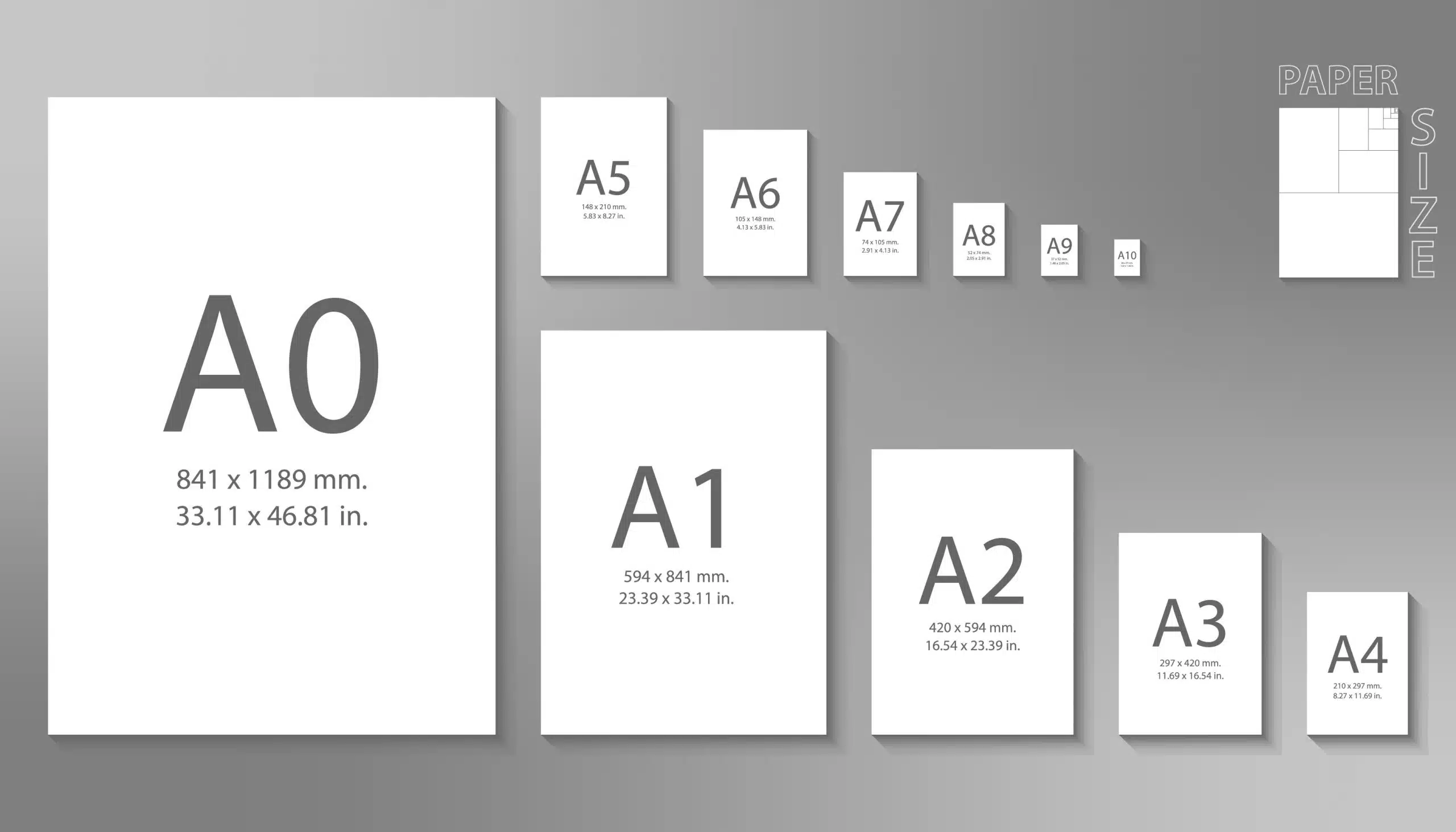Last Updated on October 17, 2023 by Carlos Alonso
Size is often a conversation topic and this article will answer the question of whether A3 is bigger than A4. It seems easy, but there are more details to consider.
A3 is bigger! It’s 11.7 x 16.5 inches or 297 x 420 mm. A4 is 8.3 x 11.7 inches or 210 x 297 mm. Width and height are both bigger with A3.
Which one is best depends on what you need it for. A3 is best for posters, presentations, and architectural drawings that need lots of space. A4 is great for letters, resumes, and other printing that needs to be handled and stored easily.
A3 may be bigger, but it also needs more space for storage and transportation.
Explanation of A3 and A4
A3 and A4 are paper sizes used around the globe. A3 measures 11.7 x 16.5 inches. A4 is 8.3 x 11.7 inches. A3 is larger than A4 in width and height.
To get a better understanding of the sizes, let’s have a closer look. Here’s a comparison of A3 and A4 in a table:
| Paper Size | Width (inches) | Height (inches) |
|---|---|---|
| A3 | 11.7 | 16.5 |
| A4 | 8.3 | 11.7 |
More details: these paper sizes belong to the ISO 216 standard. It’s used internationally for printing.
A3 is suitable for posters, newsletters, and architectural plans. This is because it has a larger format, allowing more material on one page. A4 is commonly used for letters, resumes, and reports. Why? It has a compact, easy-to-read design.
Size Comparison: A3 vs A4
A3 and A4 are two popular paper sizes used globally. A3 is larger than A4, giving more space for printing and designing. Let’s look at a size comparison!
Table:
| A3 | A4 | |
|---|---|---|
| Width | 11.69 in | 8.27 in |
| Height | 16.54 in | 11.69 in |
A3 measures 11.69 inches in width and 16.54 inches in height. A4 is smaller at 8.27 inches by 11.69 inches. This difference allows for different document formats, such as posters, diagrams, or larger prints.
Also, these two sizes belong to the ISO “A” series standard for paper measurements. This series follows a geometric progression, where each size is half the area of its predecessor.
Differences between A3 and A4
A3 & A4 are two common paper sizes – A3 being bigger. Let’s compare them to show the differences:
Dimensions:
- A3: 11.69 x 16.54 inches
- A4: 8.27 x 11.69 inches
Uses:
- A3: Posters, drawings, architectural plans
- A4: Letters, documents, brochures
Apart from size, these paper sizes are also used differently in various settings. For example, A3 is useful for creating posters, drawings & architectural plans. A4 is more suitable for everyday office tasks like letters, documents & brochures.
Pros and Cons of A3
Let’s take a look at A3 paper size – its pros and cons! We can assess these features in a concise manner with a table.
| Pros | Cons |
|---|---|
| ideal for graphical representation | larger size, which can be inconvenient for some purposes |
In addition, A3 is perfect for graphical representation, even though it has larger dimensions.
Overall, the advantages and disadvantages of A3 should be considered based on the purpose. By understanding its unique elements, one can decide if it’s the best choice.
Pros and Cons of A4
A4 paper size is a popular norm in many nations. It has various pros and cons that professionals should consider when selecting the proper paper for their needs.
- Efficient and handy: A4 paper is well-known for its flexibility, as it can be quickly folded or cut to fit different purposes. Its dimensions (210 x 297 mm) make it suitable for printing documents like letters, reports, and invoices without taking up too much room.
- Compatibility: It is compatible with the majority of printers and copiers, making sure of smooth compatibility across multiple devices. This makes it a popular option for companies and individuals.
- Cost-efficient: A4 paper is usually more affordable when compared to other sizes, making it a cost-effective solution for bulk printing needs. Its abundance also adds to its affordability.
- Convenient storage: Because of its standardized dimensions, A4 paper can be kept efficiently in folders, binders, and filing cabinets with no difficulty. This assists in organizing paperwork effectively.
- International standard: A4 is the worldwide standard for paper size, which implies that documents printed on A4 can be readily exchanged between various countries without any compatibility issues.
Also, it’s significant to remember that while A4 is extensively used and has several advantages, there might be certain scenarios where other paper sizes could be more suitable depending on individual requirements. For example, bigger paper sizes like A3 provide more room for detailed graphics or layouts.
To sum up, the pros of using A4 are its efficiency, compatibility with printers and copiers, cost-effectiveness, convenient storage options, and international standardization. However, individual preferences and particular use cases may prompt some people or businesses to choose alternative paper sizes such as A3 when needed.
Conclusion
In conclusion, A3 is bigger than A4. This size comparison matters for printing, paper dimensions, and document layouts.
The A3 and A4 sizes belong to ISO 216. A3 is 297 × 420 millimeters (11.7 × 16.5 inches). A4 is 210 × 297 millimeters (8.3 × 11.7 inches). So, A3 offers more space.
This distinction has practical implications in industries like graphic design and printing. For posters or brochures, A3 is better. For documents such as letters or reports, A4 is more suitable.
Also, these size differences apply to digital displays and online content design. Starting with the right physical dimensions is important for scalability and visual aesthetics.
Frequently Asked Questions
FAQs about A3 and A4 Paper Sizes
Q: Is A3 bigger than A4?
A: Yes, A3 is bigger than A4. A3 paper measures 297 x 420 millimeters, while A4 paper measures 210 x 297 millimeters. A3 is twice the size of A4 in terms of area.
Q: Can I print A4 documents on A3 paper?
A: Yes, you can print A4 documents on A3 paper. A3 paper can accommodate A4 size content, but there will be some empty space around the edges. You may need to adjust the print settings to fit the content properly.
Q: Which paper size is commonly used for printing documents?
A: A4 paper is the most commonly used size for printing documents. It is the standard size in many countries and is widely compatible with printers and copiers. A3 paper is typically used for larger documents or for printing posters and graphics.
Q: Can I cut an A3 sheet to make it A4 size?
A: Yes, it is possible to cut an A3 sheet to make it A4 size. By halving the longer side of the A3 sheet, you can obtain two A4 sheets. However, it is important to ensure precise cutting to maintain the proper aspect ratio and dimensions.
Q: Are there any other paper sizes larger than A3?
A: Yes, there are paper sizes larger than A3. The next standard size, A2, is twice the size of A3. Additionally, there are larger sizes like A1, A0, and even larger formats commonly used for architectural or engineering drawings.
Q: Can I resize an A4 document to A3 without losing content?
A: Resizing an A4 document to A3 without losing content may require some adjustments. The aspect ratio of A3 is different from A4, so stretching the content to fit A3 may distort the proportions. It is advisable to design documents specifically for the desired paper size to ensure accurate and optimized printing.











